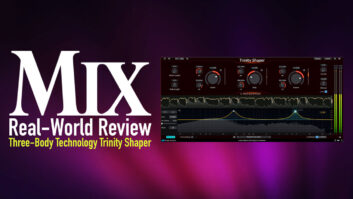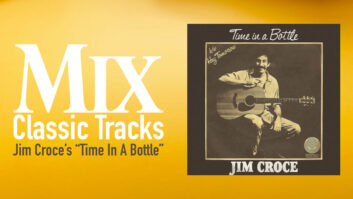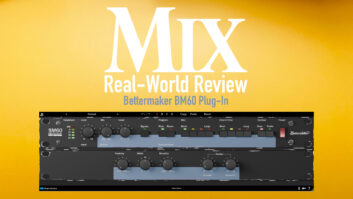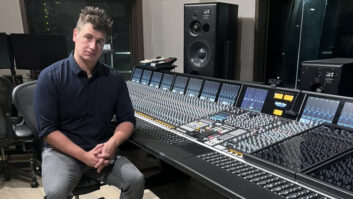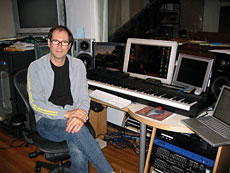
By the late 1990s, changes in technology, the financial markets and consumer taste, combined with a round of bitter labor negotiations, created a vastly altered landscape in the music for advertising marketplace, particularly in New York City’s greater metropolitan area. Gloom and doom were everywhere, and many longtime jingle and post houses decried the cheapening of their product and work migrating to the hinterlands.
Guitarist/composer Andrew Bloch of Human
As is generally the case in a fundamentally healthy capitalist environment, however, new opportunities arose, and a round of eager, talented suppliers found their way into the Manhattan music scene, including Human, Pulse and Tonefarmer.
HUMAN
Based in New York, with branches in L.A. and Europe, Human (www.humanworldwide.com) was created by guitarist/composer Andy Bloch and his partners Morgan Visconti, Gareth Williams and Marc Altschuler. In the mid-1970s, Bloch was a hard-working classical guitar student at the Mannes College of Music (part of New York City’s New School University) who moonlighted with a fusion band. These days, he seems not unlike the quiet youngster who traded Fernando Sor licks with the rest of us in-between solfege classes.
But things have changed for Bloch. He’s now a 14-year advertising music vet who cut his teeth on a GI Joe toy spot when music houses were scooping up cash. But Bloch still remembers the early days and those toy spots as the most pressure-packed of his career.
After spending several years as a freelancer, Bloch was plucked for a high-visibility staff position at JSM, one of Manhattan’s top houses at the time. JSM owner John Silberman, who started out in the business as an in-house advertising writer, knew how to craft high-impact audio. He also knew the value of style, and his rooms (designed by John Storyk) combined acoustics and accoutrements in a package that was an elixir to his client base. “JSM had four rooms with SSL consoles,” says Bloch, “and the place looked like something out of Architectural Digest. John’s vision was to create a creative community and supply them with the tools and inspiration to help them turn out their best work.
“[Silberman] certainly had his heart in the right place, but the timing — at least when I was there — was a bit off,” Bloch continues. “The industry had just suffered through a SAG strike and it killed a lot of his business, and a lot of momentum was lost. The ad industry learned how to get the job done a lot cheaper, and JSM had a huge overhead. Ironically, JSM ended up being more of an incubator than a creative juggernaut. So many great people passed through and moved on to start their own shops!”
Bloch, who stayed at JSM until 1999, when he started Human with a pair of JSM composers, Williams and Visconti (son of producer Tony Visconti), acknowledges his mentor’s influence. “The JSM experience was instrumental in establishing the ethos of Human. We really learned what is important in this business and how it can all come apart if one isn’t careful!”
Bloch started out cutting 2-inch tape and working on an old Neve board, but he understands that the studio business he grew up in is gone. What has replaced it and what changes does he envision coming to the spot industry in the near future? “Anyone can have a rocking home studio for $30,000 to $40,000,” he says, “and that includes the great mics and preamps we all love. As far as advertising music production, we face the same problems that the rest of the music production industry is dealing with: Budgets are tighter and everybody and their editor is a musician. Record companies are trying to monetize their artists and back catalogs via commercials.
“The technology has spawned a new way of creating — and listening — to music. Traditional music-making and consumption is on its last legs. The computer is so powerful now that it has really become the new instrument of the 21st century. It provides content and algorithms for compositions that enable real amateurs to pass as serious composers. As the industry continues down this path, it will be open season for people who want a shot at scoring for ads.
“Some think that music libraries are the future,” he continues. “The music library concept is as old as the hills and easier to actualize than ever — but it’s still library music! The serious filmmakers and creatives generally want to work with a composer and explore options. It’s a process, not a mail-order business.
“As much as we love to go all out and do a 60-piece date — they usually take place in Europe or South Africa — we’re very much into buying gear here at Human. We are all on Mac G5s, and I use Cubase SX as my front end. Everyone else uses Logic with Pro Tools|HD. We’re also big Gigasampler users.
“We’re not deep into exotic mics, but I’ve found that at the $800 or so price point, you have a great range of killer microphones to choose from. I love my Studio Projects T3, for example. If we need to do a really nice, live recording session, we’ll just book Clinton or Avatar and do an old-school session, although we always mix our own stuff. The amount of revisions required these days dictate that we take whatever live recording we do and tweak it back at the ranch. It’s also possible to get a good mix without knowing the first thing about mixing, thanks to great mastering programs that are on the market. The Sony Oxford Inflator is a great example of an ‘insta-mix’ plug-in: Drop it in and — bam! — the mix sounds great, especially coming over a small TV speaker system.
“As far as future plans, we’re looking at all aspects of music production: ads, films, videogames, songs/artist production, even ring tones. Right now, ad music is a vital endeavor and there’s no cultural stigma attached to it. The best people are breaking down the doors trying to get a piece, in part because it may be more adventurous and hip than most commercial music. Nobody wants corny unless it’s used ironically!
PULSE MUSIC
Musicians and producers who have enjoyed success in commercial music have become increasingly attracted to the advertising industry. Just ask Joel Kipnis, aka J.K. Kipnis carries a hefty job description at Pulse (www.pulsemusic.com): president/CEO/writer/producer.
Prior to opening his own commercial music house about a year ago, Kipnis played guitar and produced records. A Paris native, he has worked with Freddie Jackson, Johnny Kemp and Jennifer Love Hewitt, not to mention Herbie Hancock, who heard What’s the Word, Kipnis’ debut album, and asked him to co-produce and play on The Headhunters reunion album. During the past several years Kipnis has produced a number of albums, including a soon-to-be-released offering from former Fugees member John Forté.
As successful as he has been, Kipnis knows the record business’ vagaries. He also understands the cache that his resume carries and is using it to leverage the visibility of Pulse Music, which straddles the music for advertising and record worlds.
“My involvement is largely with records,” says Kipnis, “but I have also been directly involved with spot production. We’ve gone from doing things that were perceived as jingles to producing much hipper spots. Pulse writers have made records with everyone from Christina Aguilera to the rock band Lit. These guys have made huge pop and soul records, and their presence provides an exciting atmosphere that carries over to the commercial work that we do.
“For example, Supaflyers have worked with Sting and Mary J. Blige, and Adam Anders has worked with the Backstreet Boys and is currently working on the new Nick Lachey record. Put all these guys together under one roof, and you get an approach to making commercials that is not at all coming from an ad perspective. And that’s healthy.
“The advertising agencies these days are much more interested in having something authentic on their spots,” he adds. “In fact, we have new artists that we’re producing, and agencies are often intrigued by the possibility of having someone on their commercial who may become big in the near future. Asi [an artist Pulse is producing for Warner Bros.] and Gio, another artist we’re working with, are people who have a special sound that hasn’t come out yet. So what we’re finding is that the audio part of the ad business has changed in some important ways, primarily in that creatives aren’t interested in cranking out product; they want to know where a sound is coming from and what it is.”
Pulse Music has seven rooms, whose aural aesthetic combines vintage equipment and almost every software application under the sun. “We use lots of Neve and API stuff for the front end, along with Pultec and Manley gear,” Kipnis explains. “From there, we work on dual-processor G5s, Logic 7 and the latest version of Pro Tools. Plug-ins are fine, but nothing compares with the signal path that comes with a vintage tube mic taken through a Neve or Pultec compressor.
“Our favorite mic pre’s are the API 512C and Neve’s 1084 and 1073. I love the API 550A EQ and the Neve 1081, as well as the 1084. We’ve also been using Wunder Audio’s PEQ-1 mic pre/EQ module, and I like it a lot. We love Pultecs! The Neve 33609JD is also great, and we put our Distressor to use all the time, along with the Manley Vari-mu stereo compressor. We put that across the stereo bus all the time. We’re also big fans of the Chandler LTD-1 mic pre and EQ package, and the Manley Vox Box.
“As far as software goes, our favorite EQ is the Sony Oxford with the GML option. The new Apogee AD-16X converter sounds great. For monitors, the ADAM S3As are outstanding; we also use Dynaudio M3s as our large pair.
“We’re all big fans of everything that Native Instruments releases — the whole package is great. We use Absynth quite a bit. The synths in Logic are very good, and we’re big fans of Spectrasonics’ new drum module, Stylus RMX.
“I’m really excited about the way the wind is blowing in audio post right now and with music in general,” he concludes. “The common person is more excited about what music is and how it’s made, and that should pave the way for a generation of great new artists. The methods of music-making have gotten so advanced that almost anyone can make a beat and put up a song, and I think with these technical advances, the hunger for outstanding music has also grown.”
TONEFARMER
One thing’s for sure: Jingle houses have cooler names now than they did back when the typical production company’s moniker was something like “Al Smith Music.”
Founded in 2001 by Raymond Loewy (composer/sound designer) and Tiffany Warin (president/executive producer), tonefarmer (www.tonefarmer.net) is another creative music house run by a former JSM composer. Loewy, who hails from Rochester, N.Y., graduated from Duke University in 1989 and immediately started working in the music industry. Warin spent a dozen years as an advertising agency producer and account manager. A trio of composer/sound designers (David Della Santa, Joe Spallina and James Harned) and studio manager/assistant composer/engineer Casey Smith round out the staff.
Loewy says that the advertising industry has pulled itself out of the malaise caused by the dotcom bust and 9/11. “The amount of work produced continues to grow, even if the avenues of communication have started to change a bit,” he observes. “While mainstream broadcast ‘spots’ are still a major fixture on the advertising landscape, more and more attention is given to alternative media, particularly broadband and Internet marketing. These avenues can often provide shops such as ours with greater creative latitude and less-constricting schedules and deadlines.
“However, their budgets are often significantly smaller than those of traditional broadcast ads, while the amount of content required can greatly exceed what’s necessary for shorter-form television and radio spots. Therefore, these types of jobs get extra careful consideration before being taken on and committed to. We’ve had a blast working on some of these packages, however, for clients that include Sharp, United Technologies and PBS.
“The single most significant development in our business over the past several years has been the continued and growing prominence of artist-licensed music,” he continues. “As the record industry has faltered, major and independent record labels have gotten increasingly savvy to the tremendous amount of money advertisers are willing to spend to license a track. Advertisers, in turn, have grown fascinated with the possibilities of marrying their marketing messages to recognizable existing music. From fully canonized artists such as U2, the Rolling Stones and Led Zeppelin, down to impossibly obscure and/or forgotten acts like Trio, Mr. Scruff and Terry Jacks, nothing seems to escape TV advertising’s reach these days. Sometimes this option makes sense for the advertiser. Volkswagen, Reebok and Cadillac have used existing tracks to great overall effect in their advertising; some with recognizable anthems, others with alternative and lesser-known artists.
“With much television advertising today, however, it seems as if the ownership of a recognizable song — any recognizable song — is used to prop up an otherwise unremarkable spot. In the worst cases, the chosen song or track makes no sense whatsoever and can actually work against the spot’s overall message. But all of this hardly matters, and the relationship between corporate marketers and record labels will most likely continue to expand.
“Many music houses have updated their services to include song and publishing searches — and even artist/label representation — with varying degrees of success, he adds. “We have done the occasional ‘music search,’ but as of this date, we do not offer these kinds of things as an official service. At tonefarmer, we’re interested in the creation of original music and noises, and we feel that there will always be a need for thoughtful, original music scoring and sound design.”
With regard to equipment, all tonefarmer writers work on the same basic setup. Each composer suite is equipped with Logic running through Pro Tools. A fine assortment of microphones and outboard gear (Telefunken, Neumann, AKG, Manley, Focusrite, API, Giltronics, Apogee, etc.) complement the process. All sorts of other music-generating equipment — including a battery of vintage and modern guitars, basses, synths, keyboards, amps, drums and a 1986 Yamaha C7 concert grand piano — are also in-house.
Tonefarmer is located high above Chelsea in an ex-sewing machine factory that was built in 1911. The 4,000-square-foot loft’s original 2001 buildout comprised three composing suites, all tied into a 400-square-foot live room. In June 2005, phase 2 of construction brought an additional composer suite and an all-purpose “dub chapel,” which also now acts as a machine room.
“Our main goals remain as they have since we started: to provide an intimate, chill and, most of all, dedicated creative resource for our clients,” Loewy says. “Our success in an extremely crowded marketplace so far has been extremely gratifying. But success in our business can sometimes be the worst thing to happen to a young company and so we’re keeping an eye on controlling and managing the growth of the company. One of our explicit goals is not to become a 25-composer behemoth with outposts in Oslo and Shanghai.
“We really dig the musical point-of-view and family vibe that being a boutique allows and pride ourselves on not simply taking on as much work as we can get. When we commit ourselves to working on a particular job, our clients know that their project will ultimately be handled by one of tonefarmer’s four principal composers, not ‘writer #34’ or a group of six freelancers. This method of operation impedes us from taking on the volume of work that many of the other larger shops accept, but it also allows us to be streamlined and affords us the peace of mind that comes with knowing we’ll have enough time to create the best noises we possibly can come up with.”

